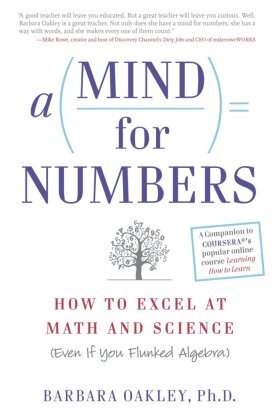A Mind for Numbers - How to Excel at Math and Science (Even If You Flunked Algebra)
| Verlag | Penguin Random House |
| Auflage | 2014 |
| Seiten | 336 |
| Gewicht | 394 g |
| Artikeltyp | Englisches Buch |
| ISBN-10 | 039916524X |
| EAN | 9780399165245 |
| Bestell-Nr | 39916524EA |
The companion book to COURSERA®'s wildly popular massive open online course "Learning How to Learn"
Whether you are a student struggling to fulfill a math or science requirement, or you are embarking on a career change that requires a new skill set, A Mind for Numbers offers the tools you need to get a better grasp of that intimidating material. Engineering professor Barbara Oakley knows firsthand how it feels to struggle with math. She flunked her way through high school math and science courses, before enlisting in the army immediately after graduation. When she saw how her lack of mathematical and technical savvy severely limited her options both to rise in the military and to explore other careers she returned to school with a newfound determination to re-tool her brain to master the very subjects that had given her so much trouble throughout her entire life.
In A Mind for Numbers, Dr. Oakley lets us in on the secrets to learning effectively secrets that even dedicated and successful students wish they d known earlier. Contrary to popular belief, math requires creative, as well as analytical, thinking. Most people think that there s only one way to do a problem, when in actuality, there are often a number of different solutions you just need the creativity to see them. For example, there are more than three hundred different known proofs of the Pythagorean Theorem. In short, studying a problem in a laser-focused way until you reach a solution is not an effective way to learn. Rather, it involves taking the time to step away from a problem and allow the more relaxed and creative part of the brain to take over. The learning strategies in this book apply not only to math and science, but to any subject in which we struggle. We all have what it takes to excel in areas that don't seem to come naturally to us at first, and learning them does not have to be as painful as we might think.
Leseprobe:
Thomas Edison is one of the most prolific inventors in history, with over one thousand patents to his name. Nothing got in the way of his creativity. Even as his lab was burning to the ground in a horrific accidental fire, Edison was excitedly sketching up plans for a new lab, even bigger and better than before. How could Edison be so phenomenally creative? The answer, as you ll see, relates to his unusual tricks for shifting his mode of thinking.
Shifting between the focused and diffuse modes
For most people, shifting from focused to diffuse mode happens naturally if you distract yourself and then allow a little time to pass. You can go for a walk, take a nap, or go to the gym. Or you can work on something that occupies other parts of your brain: listening to music, conjugating Spanish verbs, or cleaning your gerbil cage The key is to do something else until your brain is consciously free of any thought of the problem. Unless other tricks are brought into play, this generally takes several hours. You may say I don t have that kind of time. You do, however, if you simply switch your focus to other things you need to do, and mix in a little relaxing break time.
Creativity expert Howard Gruber has suggested that one of the three "B s" usually seems to do the trick: the bed, the bath, or the bus One remarkably inventive chemist of the mid-1800s, Alexander Williamson, observed that a solitary walk was worth a week in the laboratory in helping him progress in his work.(Lucky for him there were no smartphones then.) Walking spurs creativity in many fields; a number of famous writers, for example, including Jane Austen, Carl Sandburg, and Charles Dickens, found inspiration during their frequent long walks.
Once you are distracted from the problem at hand, the diffuse mode has access and can begin pinging about in its big-picture way to settle on a solution. After your break, when you return to the problem at hand, you will often be surprised at how easily the solution pops into place. Even if the solution doesn t appear, you will often be further along in your understanding. It can take a lot of hard, focused mode work beforehand, but the sudden, unexpected solution that emerges from the diffuse mode can make it feel almost like the "Ah-hah!" mode.

